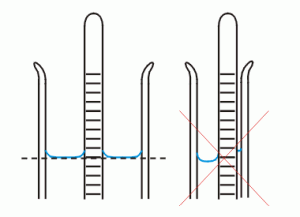 A hydrometer measures the relative density (aka Specific Gravity) of a liquid relative to the density of water. Water which contains dissolved sugar will have a density that is greater than pure water and water that contains alcohol has a density that is less than pure water. So, the hydrometer will sink further into a solution of alcohol and not sink as far into a sugar solution.
A hydrometer measures the relative density (aka Specific Gravity) of a liquid relative to the density of water. Water which contains dissolved sugar will have a density that is greater than pure water and water that contains alcohol has a density that is less than pure water. So, the hydrometer will sink further into a solution of alcohol and not sink as far into a sugar solution.
Specific Gravity has no units. It is dimensionless and defines the ratio of density of a solution to the density of water. The actual calculation can be seen below.
Specific Gravity = (Density g/cm³)/(1 g/cm³)
Different hydrometers are scaled and calibrated for different purposes. For example, a hydrometer used to measure the sugar content and potential alcohol in a whiskey mash or wine must will generally measure the Specific Gravity in a range between 0.980 – 1.150. For measuring distilled spirits you will need a liquor hydrometer which will have a proof range from 0-200 or a tralle range from 0-100.
There are a few different measurements we can get from a hydrometer. For beer, wine and whiskey mash you can determine…
- Brix or Degree Brix (°Bx) – One degree Brix is 1 gram of sugar (sucrose) dissolved in 100 grams (100 ml) of water.
- Potential Alcohol – the percent alcohol content that would result if the mash or must was fermented completely dry so no sugar remains.
For distilled spirits…
- Proof – This is a measurement of the alcohol content of a solution. In the United States it is defined as twice the percentage of alcohol by volume (ABV). So, a whiskey that is 40% alcohol is 80 Proof.
- Tralle – This is also a measurement of the alcohol content of a solution. However, the tralle scale matches the percent alcohol. So, a whiskey with 40% alcohol would have a tralle reading of 40.
Specific Gravity for Water and Ethanol
- Pure Water: Specific Gravity 1.0
- Pure Ethanol: Specific Gravity 0.785
- 50% Ethanol: Specific Gravity 0.8925
If we want to determine the Specific Gravity of a 25% alcohol solution we would could calculate this like so.
(Water L x 1.0) + (Alcohol L x 0.785) = Specific Gravity
If we plug in the numbers…
(.75L x 1.0) + (.25 L x 0.785) = 0.9463
Procedure for Using a Hydrometer
To measure the sugar content and potential alcohol of a mash you need to use a beer\wine hydrometer.
- Prepare Sample: Take a sample of the mash and pour into a test jar. The test jar can be a tall graduated cylinder or an actual jar. Just make sure that the test jar is as tall or taller than the hydrometer. You do not want the hydrometer to touch the bottom. Also, make sure that you only pour liquid into the test jar. Any solids can interfere with the reading.
- Add Hydrometer: Gently lower the hydrometer into the test jar until it is floating. I like to give it a little spin like a top to shake loose any air bubbles that might have stuck to the hydrometer. Not too hard, you do not want to break it.
- Read Hydrometer: Now you are ready to read the hydrometer. Look at the number on the hydrometer that is at the same level as the liquid (see Figure 1). You can now determine sugar content and potential alcohol.
You will use the same procedure to determine percent alcohol from your distilled mash. However, you will need to use a liquor hydrometer as it has a very different scale.
Tips and Tricks
- If the solution contains dissolved solids other than pure sucrose, only an approximate Brix reading can be determined.
- Other dissolved solids may make you reading less accurate.
- Dissolved gas can effect the hydrometer reading. Degassing is a technique that can be used to get a more accurate reading.
- All measurements are assumed that the sample is at a specific temperature. This can range from 60-68 degrees Fahrenheit. The calibration used by the manufacturer can normally be found on the packaging as well as the hydrometer itself.
Alcohol Content of Various Beverages
- Absinthe: 45% – 74%
- Barley Wine: 8% – 12%
- Beer: 3% – 12%
- Brandy: 35% – 60%
- Cider or Cyder: 2% – 8.5%
- Fortified Wines: 15.5% – 20%
- Rum: 40% – 60%
- Sake: 15% – 20%
- Whiskey: 40% – 45%
- Wine: 9% – 16%
Happy Brewing!

Recent Comments